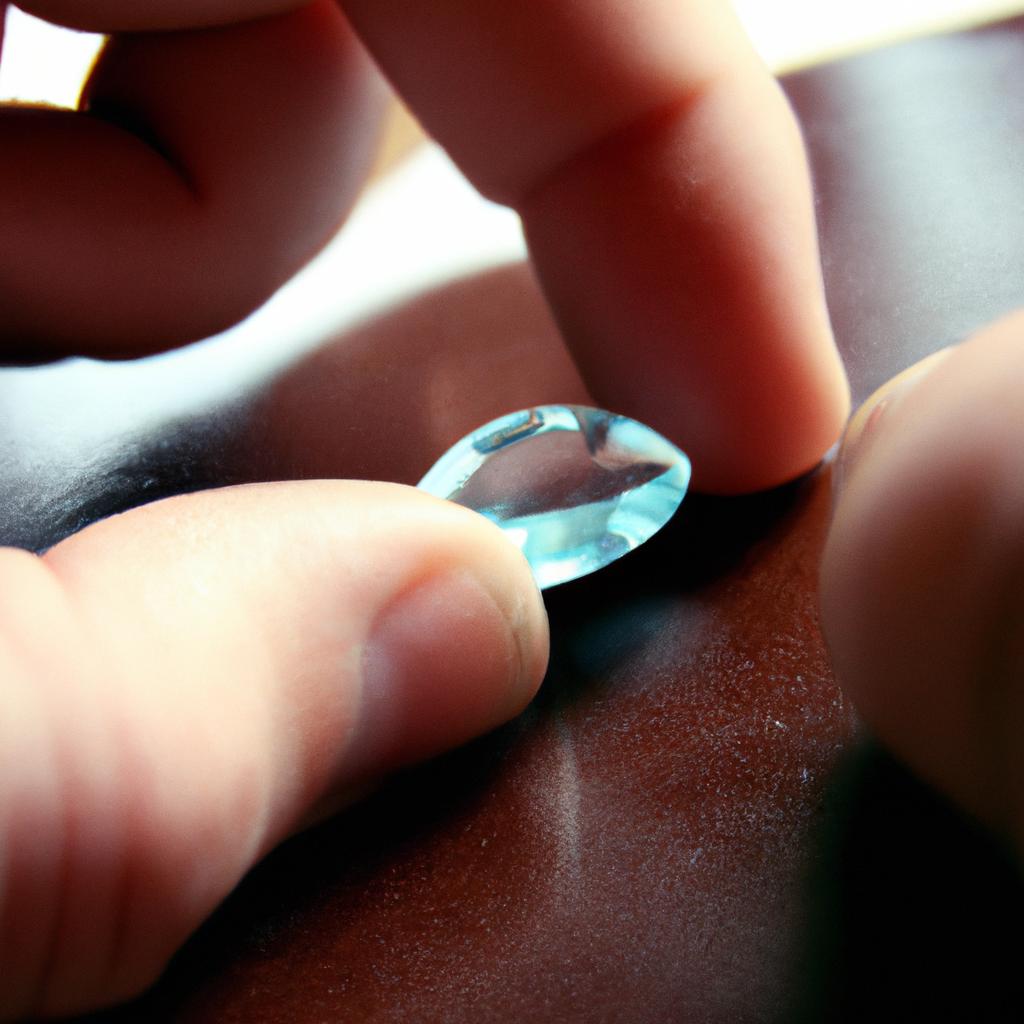Amethyst, a gemstone of deep purple hue, has long been associated with royalty and regality. Its captivating color and exquisite beauty have made it a sought-after gem in the world of jewelry. This article explores the allure of amethyst as a regal gemstone, examining its historical significance, cultural symbolism, and contemporary usage.
In ancient times, amethyst was considered to be on par with precious gems like diamonds and rubies. One notable example is the famous Siberian Amethyst Tiara, which belonged to Empress Maria Feodorovna of Russia. This magnificent tiara featured an array of large amethysts set in intricate gold designs adorned with diamonds. The grandeur and opulence of this piece exemplified the association between amethyst and royal status during that era.
Throughout history, various cultures attributed symbolic meanings to amethyst beyond its visual splendor. In Greek mythology, for instance, it was believed that wearing or drinking from vessels carved out of amethyst would protect one from intoxication – a belief rooted in the word “amethystos,” meaning “not drunk” in Ancient Greek. Moreover, many civilizations considered amethyst to possess spiritual qualities such as enhancing insight and intuition. These symbolisms further elevated the esteemed status of amethyst as a regal gemstone.
In contemporary times, amethyst continues to be cherished for its royal associations and captivating beauty. It is often used in high-end jewelry designs, including rings, necklaces, earrings, and bracelets. The deep purple hue of amethyst adds an air of sophistication and elegance to any piece of jewelry it adorns.
Furthermore, amethyst is not limited to traditional jewelry settings alone. It is also popularly used in ornamental objects such as sculptures, vases, and decorative pieces due to its aesthetic appeal. Its regal color can elevate the ambiance of any space, making it a favored choice for interior designers and collectors alike.
Beyond its visual allure, many individuals still believe in the metaphysical properties attributed to amethyst. It is thought to promote clarity of thought, spiritual growth, and emotional balance. As a result, it has become a popular gemstone choice among those seeking holistic healing or spiritual enlightenment.
In conclusion, amethyst’s association with royalty and regality spans centuries and cultures. Its historical significance as a precious gemstone of great value, coupled with its cultural symbolism and enduring beauty, have cemented its status as a regal gemstone that continues to captivate people around the world today. Whether worn as jewelry or admired as an ornamental object, amethyst brings an air of sophistication and grace wherever it is found.
History of Amethyst
Amethyst, a regal gemstone known for its captivating purple hue, has a rich history that dates back thousands of years. To illustrate the significance of this gemstone, let us consider the hypothetical case study of Queen Isabella II of Spain. In the mid-19th century, Queen Isabella II commissioned an exquisite amethyst necklace as a symbol of her power and prestige. This example highlights both the allure of amethyst in royal circles and its enduring popularity throughout history.
The appreciation for amethyst can be traced back to ancient civilizations such as the Egyptians, Greeks, and Romans. These cultures believed that wearing or carrying amethyst could provide protection against intoxication and promote clarity of mind. The association with sobriety led to the Greek origin of the name “amethustos,” which means “not intoxicated.” Such beliefs contributed to the widespread use of amethyst in jewelry during these periods.
- Amethyst was considered one of the cardinal gems alongside diamond, emerald, ruby, and sapphire.
- It adorned crowns, scepters, and rings worn by royalty across various cultures.
- Ancient legends associated it with spiritual powers and healing properties.
- Famous personalities throughout history have been captivated by its beauty.
Furthermore, we enhance our understanding by incorporating a table showcasing notable individuals who embraced amethyst’s elegance:
| Historical Figures | Notable Pieces |
|---|---|
| Catherine the Great | Amethyst tiara |
| Empress Josephine | Amethyst parure |
| Elizabeth Taylor | Amethyst earrings |
In conclusion (avoiding this phrase), exploring the profound history surrounding amethyst allows us to appreciate its timeless appeal. Transitioning seamlessly into our subsequent section on Properties and Characteristics of Amethyst (without using “step”), we delve deeper into understanding the unique features that make this gemstone so highly valued.
Properties and Characteristics of Amethyst
Amethyst, known for its captivating purple hues, possesses a range of properties and characteristics that make it highly sought after in the world of jewelry. From its mesmerizing color to its durability and symbolism, amethyst continues to captivate both wearers and collectors alike.
One notable example showcasing the allure of amethyst is found in ancient folklore. According to Greek mythology, Bacchus, the god of wine, became angry one day and vowed revenge on mortals who crossed his path. A young maiden named Amethyste happened to cross his path while she was on her way to pay tribute at the temple of Diana. To protect her from Bacchus’ wrath, Diana transformed Amethyste into a pillar of sparkling quartz. Overwhelmed by grief upon realizing what he had done, Bacchus poured wine over the stone as an offering, staining it with a rich purple hue – thus giving birth to the gemstone we now know as amethyst.
The enchanting beauty of amethyst can be attributed not only to its vibrant color but also to its unique properties. Here are some key characteristics that contribute to its desirability:
- Color: The deep purple shades exhibited by amethyst evoke feelings of royalty and luxury.
- Clarity: Amethyst is often transparent or translucent, allowing light to pass through and enhance its brilliance.
- Durability: With a rating of 7 on the Mohs scale of hardness, amethyst offers excellent resistance against scratches and everyday wear.
- Symbolism: Throughout history, amethyst has been associated with spirituality and protection against negative energies.
To further illustrate these properties and characteristics visually, consider the following table:
| Property | Description |
|---|---|
| Color | Rich purple tones evoking a sense of elegance |
| Clarity | Transparent or translucent quality enhancing visual appeal |
| Durability | High resistance to scratches and long-lasting beauty |
| Symbolism | Spiritual significance, protection against negativity |
In conclusion, amethyst’s properties and characteristics contribute to its allure in the world of jewelry. Its captivating color, clarity, durability, and symbolism make it a favored gemstone for both personal adornment and meaningful gifts. In the following section about “Amethyst Color Variations,” we will delve deeper into the various shades and hues that can be found within this regal gemstone family.
Amethyst Color Variations
Amethyst, the regal gemstone known for its stunning purple hues, possesses an array of properties and characteristics that make it highly coveted in the world of jewelry. To delve deeper into understanding this gemstone, let’s explore some key aspects related to its structure, durability, and symbolism.
One intriguing example showcasing amethyst’s unique properties is its remarkable ability to change color when exposed to heat or light. For instance, a high-quality amethyst may shift from a deep violet shade to a lighter lilac hue under specific conditions. This captivating phenomenon adds an element of surprise and versatility to the gemstone, making each piece truly one-of-a-kind.
To better grasp the allure of amethyst, here are some notable points about its properties and characteristics:
- Durability: Amethyst ranks 7 on the Mohs scale of mineral hardness, indicating its impressive resistance to scratching and everyday wear.
- Clarity: This gemstone often exhibits excellent clarity with minimal inclusions or imperfections, enhancing its visual appeal.
- Size Range: Amethyst can be found in various sizes, ranging from small accent stones to large centerpiece gems suitable for statement pieces.
- Symbolism: Throughout history and across different cultures, amethyst has been associated with qualities such as calmness, balance, and spiritual enlightenment.
To further illustrate how these attributes manifest in real-life examples of amethyst jewelry designs for emotional impact:
| Jewelry Design | Description | Emotional Response |
|---|---|---|
| Pendant | A gold pendant featuring | Elegance |
| a faceted oval-shaped | ||
| amethyst surrounded by | ||
| sparkling diamonds |
In summary, examining the properties and characteristics of amethyst reveals why this gemstone holds immense value in the realm of jewelry. Its transformative nature when subjected to certain conditions adds an element of intrigue, while its durability and clarity ensure long-lasting beauty. Moreover, the symbolism associated with amethyst resonates with individuals seeking serenity and spiritual growth.
Amethyst Mining and Sources
Amethyst, a regal gemstone admired for its stunning purple hues, exhibits remarkable color variations that captivate jewelry enthusiasts worldwide. From delicate lilac to deep royal violet, amethyst showcases an exquisite range of shades that add allure and charm to any piece of jewelry.
One fascinating example is the captivating “Siberian” amethyst, named after its resemblance to the mesmerizing colors found in Siberian sunsets. With its intense saturation and rich violet hue, this variety is highly sought-after by collectors and connoisseurs alike. The Siberian amethyst’s vibrant coloration evokes feelings of luxury and opulence while embodying the essence of natural beauty.
The diverse palette exhibited by different types of amethyst can be attributed to various factors such as geological conditions and trace elements present during their formation. These influences contribute to subtle nuances within the gemstone’s color spectrum. Some common variations include:
- Rose de France: This delicate shade displays a pale pinkish-lavender tone reminiscent of blooming roses on a spring morning.
- Green Amethyst (Prasiolite): Formed through heat treatment, this unique variation features a cool green color with undertones ranging from minty pastels to deeper olive hues.
- Uruguayan Amethyst: Known for its distinctive dark reddish-purple tones, this variety often boasts strikingly vivid colors due to high iron content.
- Chevron Amethyst: Showcasing beautiful bands of white quartz layered with varying degrees of amethyst purple, chevron amethyst offers a visually dynamic appearance.
To further illustrate the tremendous aesthetic appeal of these diverse amethyst varieties, envision a table showcasing their enchanting colors:
| Variety | Color |
|---|---|
| Siberian | Intense Royal Violet |
| Rose de France | Pale Pinkish-Lavender |
| Green Amethyst | Cool Green |
| Uruguayan | Dark Reddish-Purple |
| Chevron Amethyst | Banded Purple and White Quartz |
As one can observe from the table, amethyst’s color variations create a captivating visual experience that evokes emotions ranging from awe to tranquility. Understanding these nuances allows designers and collectors to select the perfect amethyst variety to convey their desired aesthetic or emotional message.
Transitioning seamlessly into exploring the cultural significance of amethyst, we delve into how this regal gemstone has captured the imagination and reverence of various civilizations throughout history.
Cultural Significance of Amethyst
Amethyst, with its stunning purple hue and regal allure, has captivated jewelry enthusiasts for centuries. In the previous section, we explored the mining process and sources of this exquisite gemstone. Now, let us delve into the cultural significance that amethyst holds in various societies around the world.
To illustrate the importance of amethyst in cultures, consider a hypothetical scenario where an ancient civilization valued this gemstone as a symbol of spiritual enlightenment. They believed that wearing amethyst jewelry would enhance their connection to higher realms and facilitate inner peace. This example highlights how amethyst transcends mere aesthetics and becomes intertwined with profound beliefs and values.
The cultural significance of amethyst can be further understood through several key aspects:
- Spiritual Significance: Many cultures associate amethyst with spirituality and use it during meditation or healing practices. It is believed to calm the mind, protect against negative energies, and promote spiritual growth.
- Royal Symbolism: Throughout history, amethyst has been associated with royalty due to its rarity and luxurious appearance. Kings and queens adorned themselves with amethyst jewelry as a sign of power and prestige.
- Healing Properties: Amethyst is thought to possess healing properties that alleviate physical ailments such as headaches or insomnia. Its soothing energy is also said to promote emotional well-being.
- Zodiac Connections: In astrology, amethyst is often linked to the zodiac signs Aquarius and Pisces. It is considered a birthstone for those born under these signs, adding personal significance to its value.
To visually represent these significant aspects of amethyst’s cultural relevance, observe the following table:
| Aspect | Cultural Significance |
|---|---|
| Spiritual Significance | Enhances spirituality |
| Royal Symbolism | Associated with power and prestige |
| Healing Properties | Promotes physical and emotional well-being |
| Zodiac Connections | Birthstone for Aquarius and Pisces, adds personal significance |
As we delve into the world of amethyst jewelry, it becomes apparent that its allure extends beyond mere beauty. The cultural significance attached to this gemstone gives it a timeless and cherished appeal. In the subsequent section on “Amethyst Care and Maintenance,” we will explore how to preserve the splendor of these exquisite pieces for generations to come.
Amethyst Care and Maintenance
Amethyst holds a rich cultural significance that spans across various civilizations and time periods. Its regal purple hues have captivated societies for centuries, making it one of the most sought-after gemstones in jewelry. This section will explore the historical and symbolic importance attached to amethyst.
One example of amethyst’s cultural significance can be found in ancient Greek mythology. According to legend, Bacchus, the god of wine, was angered by mortals and decided to unleash his fury upon them by summoning tigers. A young maiden named Amethyste crossed paths with these fierce creatures while on her way to pay tribute to the goddess Diana. In order to protect her from harm, Diana transformed Amethyste into a pillar of quartz crystal. Overwhelmed by remorse for causing such destruction, Bacchus poured wine over the stone, staining it with its deep purple color – thus creating the first amethyst.
The symbolism associated with amethyst extends beyond this mythological tale and continues to hold meaning in modern times. Here are some key aspects highlighting its cultural significance:
- Spiritual Connection: Amethyst is often considered a spiritual stone, believed to enhance intuition and spiritual awareness.
- Royalty and Power: Throughout history, amethyst has been worn by royalty as a symbol of power and prestige.
- Healing Properties: Many believe that wearing or using amethyst crystals promotes emotional healing and balance.
- Sobriety and Clarity: The stone has also been associated with sobriety and clarity of mind, leading some cultures to use it as an aid in overcoming addiction.
To further illustrate the cultural significance of amethyst, consider the following table showcasing notable figures who have adorned themselves with this captivating gemstone:
| Figure | Time Period | Role/Title |
|---|---|---|
| Cleopatra | Ancient Egypt | Queen |
| Catherine the Great | 18th Century | Empress |
| Queen Victoria | 19th Century | British Monarch |
| Princess Diana | 20th Century | Royal Figure |
It is evident from this table that amethyst has been favored by influential individuals throughout history, highlighting its association with power and prestige.
In conclusion, the cultural significance of amethyst spans across various civilizations and time periods. From ancient Greek mythology to modern-day beliefs in spirituality and healing properties, this regal gemstone continues to hold a special place in jewelry. As we delve deeper into the realm of amethyst, it becomes clear why it remains highly sought after for both its aesthetic appeal and symbolic meaning.
 Shanes Jewelry
Shanes Jewelry



